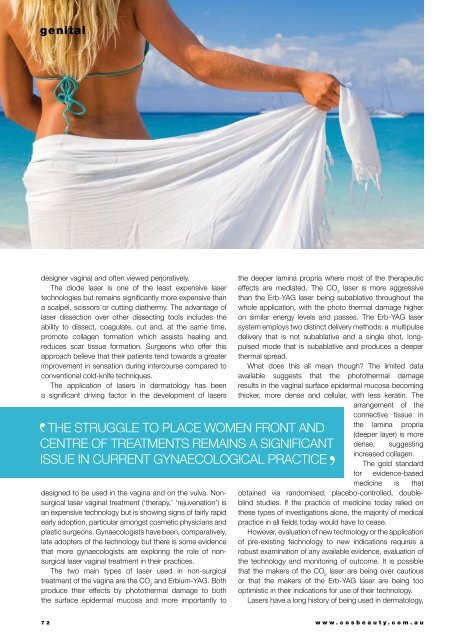Cosmetic Surgery & Beauty #71
Cosmetic Surgery & Beauty magazine is the go to guide for anyone considering an aesthetic procedure or treatment. Written by medical journalists and industry experts CSBM covers everything you need to know and with hundreds of untouched before and after photos it is the authoritative information source.
Cosmetic Surgery & Beauty magazine is the go to guide for anyone considering an aesthetic procedure or treatment. Written by medical journalists and industry experts CSBM covers everything you need to know and with hundreds of untouched before and after photos it is the authoritative information source.
You also want an ePaper? Increase the reach of your titles
YUMPU automatically turns print PDFs into web optimized ePapers that Google loves.
genital<br />
designer vagina) and often viewed perjoratively.<br />
The diode laser is one of the least expensive laser<br />
technologies but remains significantly more expensive than<br />
a scalpel, scissors or cutting diathermy. The advantage of<br />
laser dissection over other dissecting tools includes the<br />
ability to dissect, coagulate, cut and, at the same time,<br />
promote collagen formation which assists healing and<br />
reduces scar tissue formation. Surgeons who offer this<br />
approach believe that their patients tend towards a greater<br />
improvement in sensation during intercourse compared to<br />
conventional cold-knife techniques.<br />
The application of lasers in dermatology has been<br />
a significant driving factor in the development of lasers<br />
designed to be used in the vagina and on the vulva. Nonsurgical<br />
laser vaginal treatment (‘therapy,’ ‘rejuvenation’) is<br />
an expensive technology but is showing signs of fairly rapid<br />
early adoption, particular amongst cosmetic physicians and<br />
plastic surgeons. Gynaecologists have been, comparatively,<br />
late adopters of the technology but there is some evidence<br />
that more gynaecologists are exploring the role of nonsurgical<br />
laser vaginal treatment in their practices.<br />
The two main types of laser used in non-surgical<br />
treatment of the vagina are the CO 2<br />
and Erbium-YAG. Both<br />
produce their effects by photothermal damage to both<br />
the surface epidermal mucosa and more importantly to<br />
the deeper lamina propria where most of the therapeutic<br />
effects are mediated. The CO 2<br />
laser is more aggressive<br />
than the Erb-YAG laser being subablative throughout the<br />
whole application, with the photo thermal damage higher<br />
on similar energy levels and passes. The Erb-YAG laser<br />
system employs two distinct delivery methods: a multipulse<br />
delivery that is not subablative and a single shot, longpulsed<br />
mode that is subablative and produces a deeper<br />
thermal spread.<br />
What does this all mean though? The limited data<br />
available suggests that the photothermal damage<br />
results in the vaginal surface epidermal mucosa becoming<br />
thicker, more dense and cellular, with less keratin. The<br />
arrangement of the<br />
connective tissue in<br />
the lamina propria<br />
The struggle to place women front and<br />
centre of trEATments remains a significant<br />
issue in current gynaecological practice<br />
(deeper layer) is more<br />
dense, suggesting<br />
increased collagen.<br />
The gold standard<br />
for evidence-based<br />
medicine is that<br />
obtained via randomised, placebo-controlled, doubleblind<br />
studies. If the practice of medicine today relied on<br />
these types of investigations alone, the majority of medical<br />
practice in all fields today would have to cease.<br />
However, evaluation of new technology or the application<br />
of pre-existing technology to new indications requires a<br />
robust examination of any available evidence, evaluation of<br />
the technology and monitoring of outcome. It is possible<br />
that the makers of the CO 2<br />
laser are being over cautious<br />
or that the makers of the Erb-YAG laser are being too<br />
optimistic in their indications for use of their technology.<br />
Lasers have a long history of being used in dermatology,<br />
72 www.cosbeauty.com.au


















